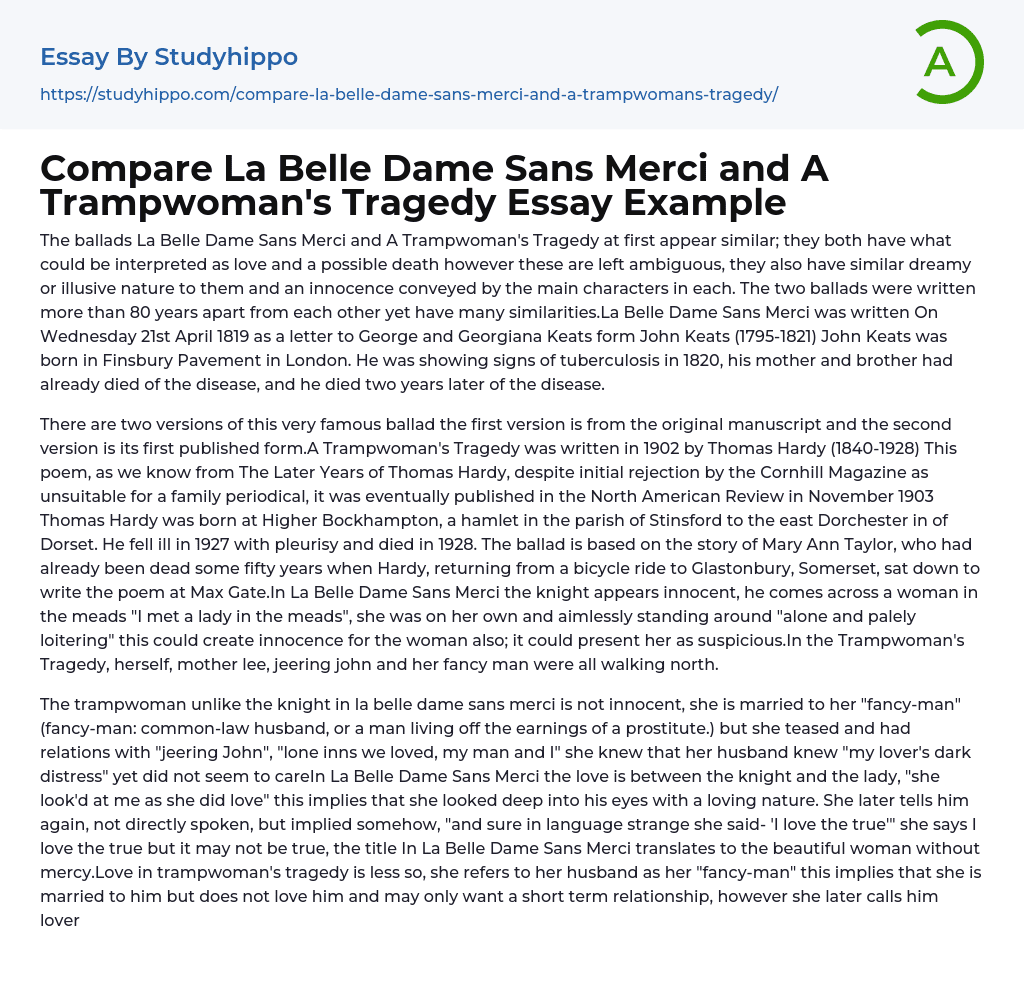

Compare La Belle Dame Sans Merci and A Trampwoman’s Tragedy Essay Example
Although written over 80 years apart, the ballads "La Belle Dame Sans Merci" and "A Trampwoman's Tragedy" share similarities. Both convey a vague sense of love and possible death, with a dreamy or illusory tone and innocent main characters. "La Belle Dame Sans Merci" was written by John Keats on April 21, 1819 as a letter to George and Georgiana Keats. Keats himself was born in Finsbury Pavement in London, and tragically succumbed to tuberculosis two years after writing the ballad - a disease that had already claimed the lives of his mother and brother.
Thomas Hardy wrote A Trampwoman's Tragedy in 1902, which has two versions: one from the original manuscript and the other from its first published form. Despite rejection by the Cornhill Magazine, it was eventually published in the North American
...Review in November 1903. The ballad tells the story of Mary Ann Taylor, and Hardy wrote it at Max Gate after returning from a bicycle ride to Glastonbury, Somerset. Hardy was born in Higher Bockhampton and died in 1928 after falling ill with pleurisy in 1927. In La Belle Dame Sans Merci, the knight appears innocent as he meets a woman in the meads, who was alone and aimlessly standing around, which could create suspicion for her. In the Trampwoman's Tragedy, herself, mother lee, jeering john, and her fancy man were walking north.
The Trampwoman, in contrast to the Knight in La Belle Dame Sans Merci, is not innocent. She is married to her "fancy-man" (a man who lives off the earnings of a prostitute or a common-law husband). Even though she had relations with "jeering John" and loved the inns that she
and her husband frequented, she knew that her man was aware of "my lover's dark distress" yet did not show any concern. Love in this tragedy is less significant, and the Trampwoman only refers to her husband as her "fancy-man," which suggests that she does not love him and may want a short-term relationship. However, later on, she called him her lover "my lover's dark distress." This is after the Trampwoman put John's hand on her waist "laid his hand my waist upon," so this could have been guilt. In La Belle Dame Sans Merci, the love between the Knight and the Lady is intense, and she looked at him with love in her eyes "she looked at me as she did love." Later, she tells him that she loves him, but it may not be true - "and sure in language strange she said-'I love the true.'" The title of the poem means 'the beautiful woman without mercy.' This love triangle exemplifies courtly love.
La Belle Dame Sans Merci portrays a perplexing demise where the protagonist takes the narrator to a secluded place, referred to as her "elfin grot". In the subsequent stanza, the narrator discloses that he silenced her unrestrained eyes with four kisses, suggesting that he may have killed her due to her erratic behavior. Following this, he recounts how she lulled him to sleep and reveals that his final dream on the chilly hillside was one of despair.
The possibility that he was lulled to sleep by thoughts of her and the image of her that he remembers from when she was alive is present. The phrase "On cold hillside" implies that
he is alone and cold on a hillside, and the regret of killing her seems to be evident. A Trampwoman's Tragedy clearly depicts death, unlike La Belle Dame Sans Merci, where the killing remains ambiguous.
The Fancy-man uses his knife to end the life of Jeering Johnny, potentially due to jealousy or to protect his wife. In La Belle Dame Sans Merci, the knight dreams of seeing pale kings and warriors, warning him that the Lady sans merci has him in her grasp after he kills her. A Trampwoman's Tragedy features a dream-like quality with the repeated phrases "the taverns tell the gloomy tale" and "thereafter I walked the world alone." This repetition suggests exhaustion for the trampwoman, Mother Lee, Jeering John, and the Fancy-man.
Despite being composed by different individuals with an interval of more than 80 years, the two ballads share similar tone, style and emotional content. Additionally, they exhibit a comparable structure featuring circular endings that are connected to the beginning. Nevertheless, there are differences between them as well; for instance, while the death of John is evident in A Trampwoman's Tragedy, it remains obscure in La Belle Dame Sans Merci. Overall, despite subtle variations in factual details, the two ballads are largely alike.
- Book Summary essays
- Metaphor essays
- Reader essays
- Rhyme essays
- Literary devices essays
- Villain essays
- Books essays
- Genre essays
- Literary Criticism essays
- Writer essays
- Protagonist essays
- Simile essays
- Poem essays
- Book Report essays
- Book Review essays
- Greek Mythology essays
- Plot essays
- Tragic Hero essays
- Coming of Age essays
- Play essays
- Rhetoric essays
- Rhetorical Question essays
- Translation essays
- Understanding essays
- Reason essays
- Character essays
- Letter essays
- American Literature essays
- Literature Review essays
- Utopia essays
- Poetry Analysis essays
- Dante's Inferno essays
- Between The World and Me essays
- Incidents in The Life of a Slave Girl essays
- Flowers for Algernon essays
- Myth essays
- Everyday Use essays
- Boo Radley essays
- Genesis essays
- Richard iii essays
- Alice in Wonderland essays
- On the road essays
- Ozymandias essays
- The Nightingale essays
- Holden Caulfield essays
- Animal Farm essays
- 1984 essays
- A Hanging essays
- Shooting An Elephant essays
- A Tale Of Two Cities essays



